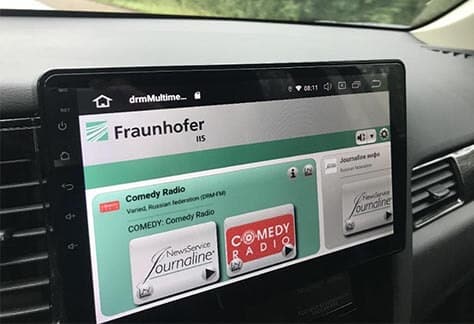Russian company Digiton Systems has been carrying out a high-power field trial of the DRM standard in the FM band using the simulcast mode (parallel DRM and analog FM transmission from a single transmitter). The testing started in St. Petersburg in 2019, and the company has just made public the trial results from June to December 2019. The Russian Television and Radio Broadcasting Network ordered and funded the effort, with support by key members of the DRM Consortium.
The objective of the simulcast DRM and analog FM demonstration was to measure the coverage performance of DRM in the FM band and to verify the predictions made for the coverage area. Testers also wanted to ascertain that there is no interference to analog FM by DRM FM during simulcast transmission.
The trial was conducted in the northwest section of the Russian Federation in the St Petersburg region. The area is a mixture of dense urban, urban, suburban, and rural terrain, including the city of Saint-Petersburg, several towns, open farmland, industrial districts and open water.
DRM Consortium members, RFmondial GmbH and Fraunhofer IIS, helped enable the system to be tested in a real commercial environment with a wide variety of reception conditions. Digiton Systems provided equipment, project management and the measuring effort for the trial. The Russian company Triada TV provided the transmitter.
The European Media Group and GPM Radio allowed the transmission of the digital DRM signal from their FM radio stations Studio 21 (95.5 MHz) and Comedy Radio (95.9 MHz), respectively.
Overall coverage was measured by driving along all major routes through the region, around 1500 route kilometers in total. Digiton Systems outfitted a Mitsubishi Outlander and a Hyundai Solaris to take the measurements. The test vehicles were equipped with an RFmondial RF-SE19 receiver, Kathrein K 51 16 4/510 351 receiving antenna and Gospell GR-216 consumer receiver. In addition, the Outlander had the Fraunhofer DRM MultimediaPlayer radio app installed with an external FM receiver dongle connected via USB.
According to a summary by DRM, notable findings from the trial include:
- For DRM simulcast with a frequency offset 150 kHz, the DRM digital signal does not interfere with analog FM signal with power difference of up to –10 dB.
- For the frequency offset of 200 kHz DRM, the digital signal does not interfere with the analog FM signal at any power values that the transmitter could provide.
- There was no disturbance by DRM FM to any of the adjacent analog transmissions at 105.1 MHz and 105.5 MHz.
- Professional receivers were used for measurements, desktop radios and cars were used to tune into the actual programs featuring the latest audio codec (xHE-AAC) as well as Journaline text and images.
- The measured coverage area exceeded prediction, which is one of the main findings of the test.
- Commercial broadcasters support the DRM simulcast mode as an alternative to the DAB+ standard, because DRM simulcast broadcasts allow FM broadcasting and the launch of terrestrial digital radio broadcasting in the same frequency range. DRM multiplexes can be launched between existing FM radio stations without interfering with them. To do this, one transmitter and existing combiner and antenna system can be used.
- The sound quality is comparable to that of existing FM radio stations. The recommendation is to use the advanced codec MPEG-4 xHE-AAC with a bitrate of at least 30 kbps.
-
All the equipment necessary for the DRM simulcast in FM band (87.5–108.0 MHz) is commercially available on the market.
The trial is continuing at the moment. More detailed findings will be included in a report to be made available to the ITU.
Access the 2019 results report on the Digital Radio Mondiale website.

